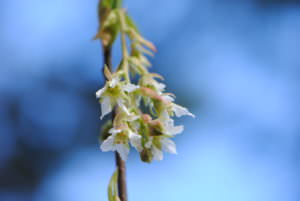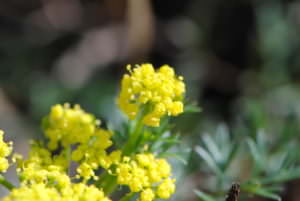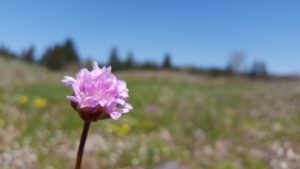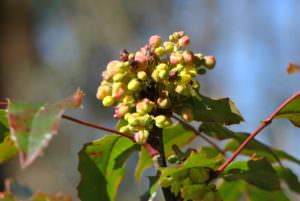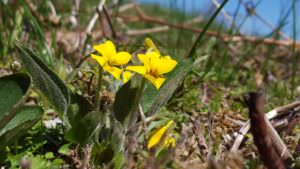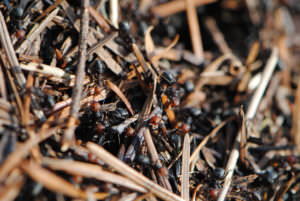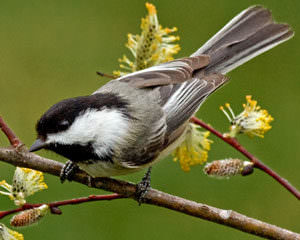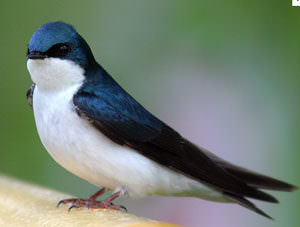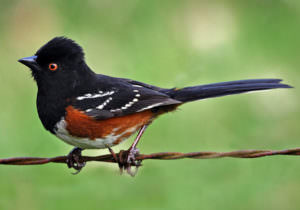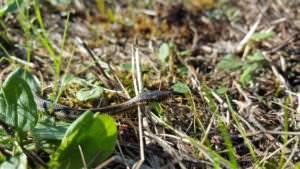What to See on the Prairie Now
If you get a chance to come to Wolf Haven International, you will be lucky enough to have a chance to see beautiful native plants and wildlife on Wolf Haven’s unique mounded prairie. For the next few months, I will be letting people know what they can expect to see on the prairie.
Early March brought the warm, wet weather that the plants love, and there was an explosion of growth! Along the edges of the prairie, the early blooming Indian plum (Oemleria cerasiformis) started off strong, along with the first green shoots of the camas plants, which will paint the prairie purple in May.
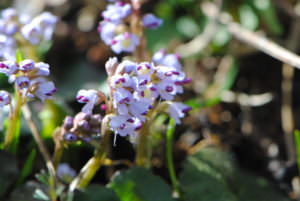
Snow Queen
Along Wolf Haven’s prairie path you will be able to see the small, light purple snow queen (Synthyris reniformis) and the yellow biscuitroot (Lomatium sp.) popping up
everywhere. The Biscuitroot makes pocket gophers extra happy, since they love to pull the plants underground by their roots and eat the whole thing. Nearer to the Grandfather Tree, you might see the pink flowers of sea thrift (Armeria maritima) on long green stalks. The sea thrift and some of the biscuitroot was planted by the Center for Natural Lands Management in November, and had to be protected all winter from being pulled out by Wolf Haven’s resident ravens, and they managed to survive the winter!
In Wolf Haven’s forested areas, the tall oregon grape (Mahonia aquifolium) and yellow wood violet (Viola biflora) are beginning to get their flowers. Keep an eye on your feet as you walk under the Grandfather Tree, since the thatch mound ants (Formica obscuripes) are waking up for the warm season and their attack is painful if you step into one of their gigantic anthills.
I would also bring a pair of binoculars if you have them, since the birds are out and singing up a storm. Chestnut and Black-capped Chickadees are hopping around the trees, along with Dark-eyed Juncos, and Golden-crowned Kinglets. Spotted Towhees and American Robins are calling, from shrubs.
Turn your binoculars to one of the many snags on the prairie if you hear the drumming, there might be a Downy Woodpecker or a Northern Flicker hammering away in search of insects. Bald eagles and Red-tailed Hawks often sit on top of the Grandfather Tree and the snags around the Prairie. If you hear a chattering above you, look up to see the aerial aerobatics of Tree Swallows as they zoom around, eating flying insects.
There are many wooden boxes on poles spread around the prairie, these are nest boxes for Western Bluebirds, but often Tree Swallows make nests in them instead. If you want to keep an eye on the bluebird boxes from your home, one of Wolf Haven’s has a Washington Fish and Wildlife live web cam in it, which you can watch here: http://wdfw.wa.gov/wildwatch/bluebirdcam/video.html , so far I have only seen tree swallows checking it out. Of course, there is always Wolf Haven’s Corvid population, with many Common Ravens, American Crows, and Steller’s Jays making noise and imitating Red Tailed Hawk calls.
As far as non-birds go, March is chorus frog breeding season, and their ribbits can be heard from Wolf Haven’s adjoining wetland. If it is a sunny day, there might be a garter snake or two in the grass or on the path, warming themselves in the light. After dark, Wolf Haven might be closed, but the bat boxes near the parking lot are always open for bats, which have been leaving guano (poo) below them, to let us know the bats are here!
Wolf Haven International is on their Spring/Summer schedule from April 2 – September 30, which means we’re open to the public six days a week (always closed on Tuesday). Be sure to visit the prairie when you come to Wolf Haven so you can see all the cool things I’m seeing!
Anne Schuster,
Center for Natural Lands Management AmeriCorps,
Wolf Haven Outreach and Restoration Technician

